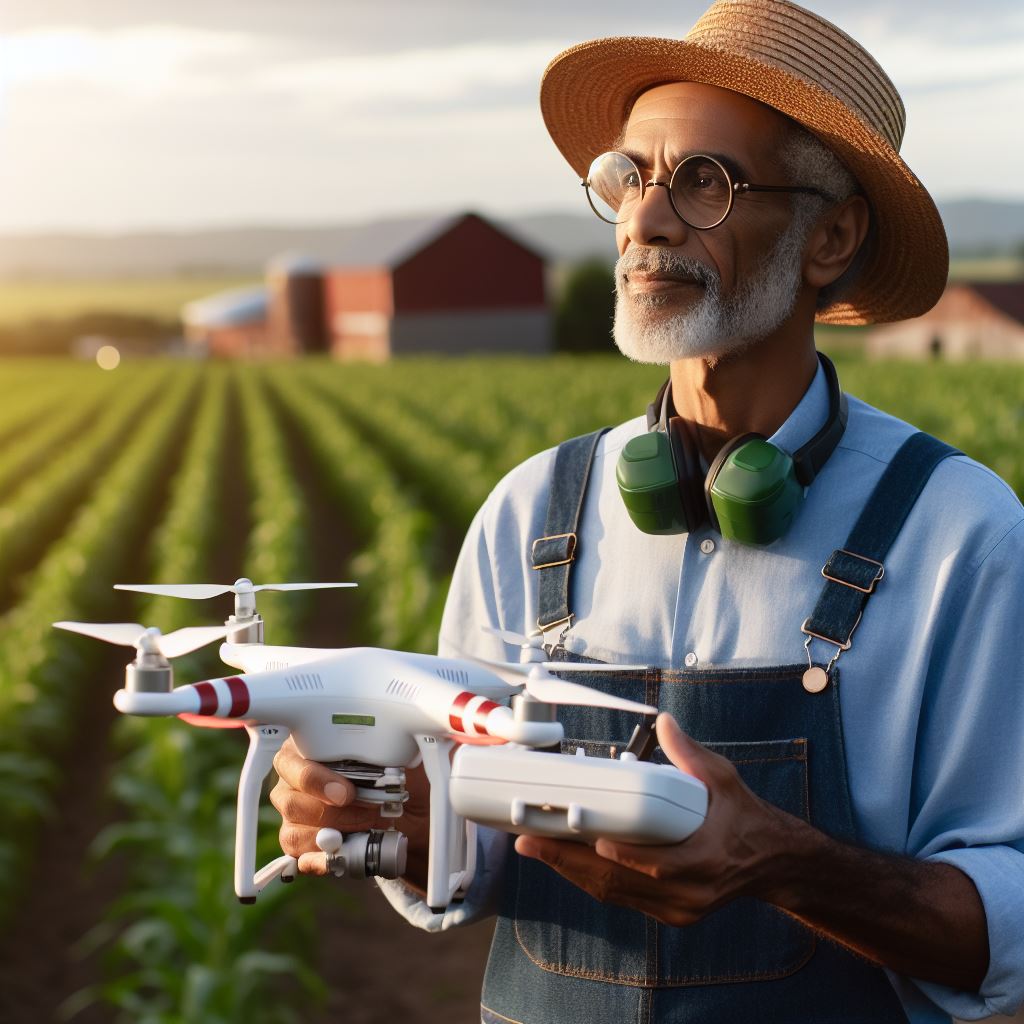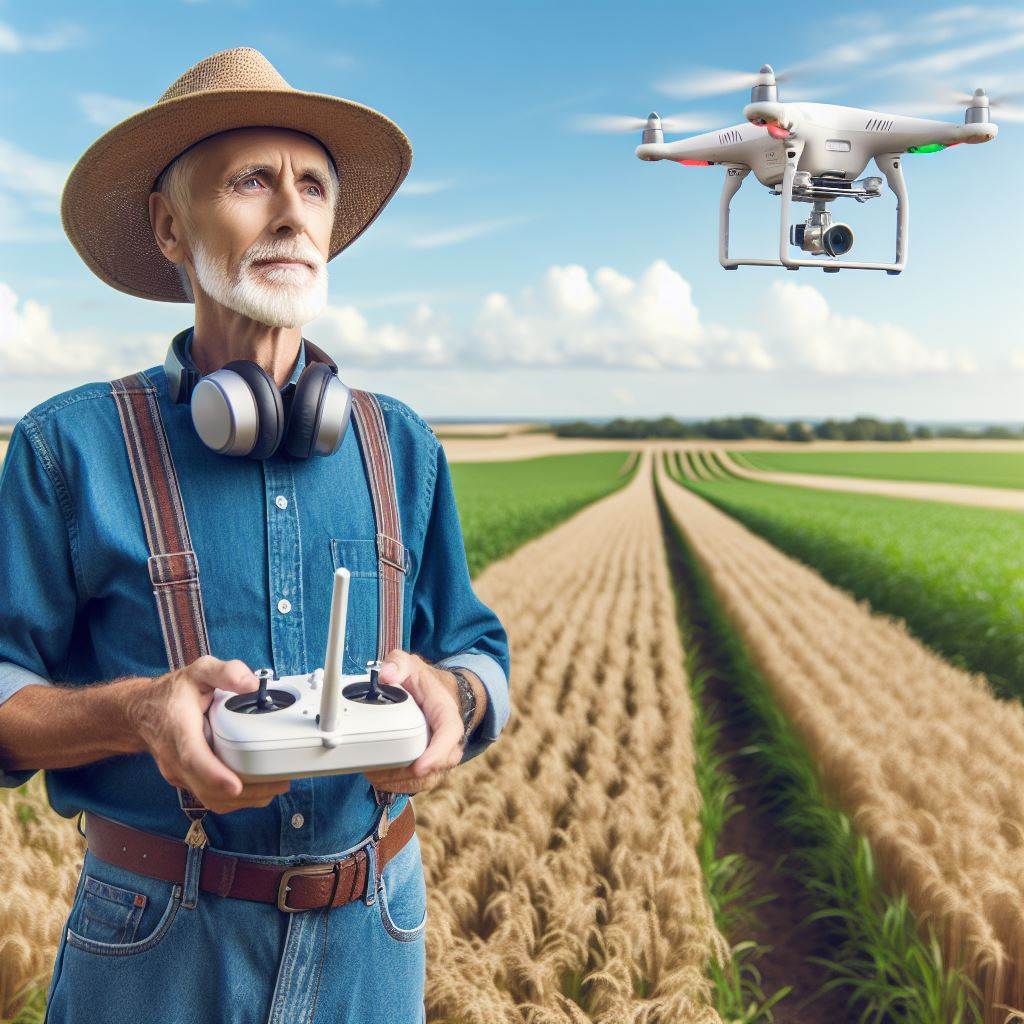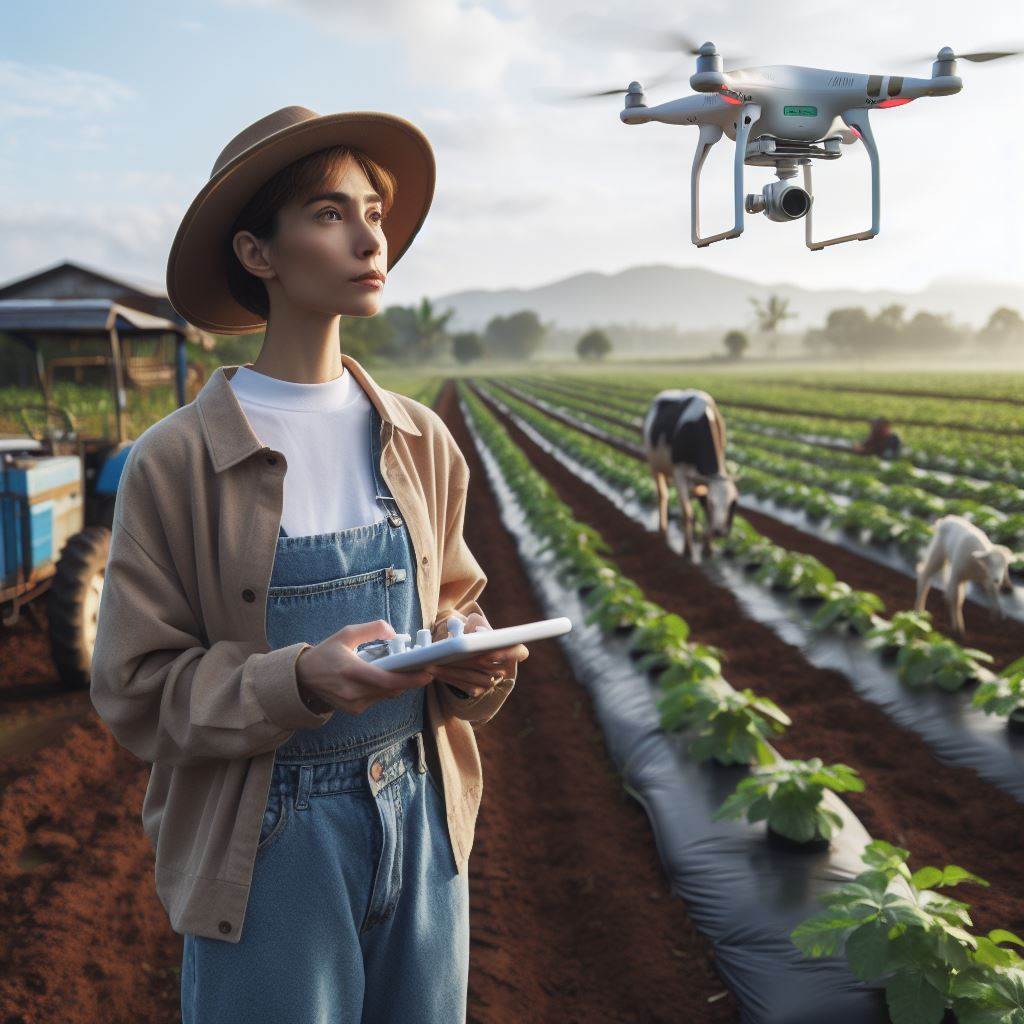Introduction
A. The concept of Sky Farming
Sky farming is an innovative agricultural technique that utilizes tall buildings and vertical growing spaces to produce food crops in urban environments.
As cities continue to expand, sky farming enables local food production without claiming more horizontal land.
B. Increasing use of drones in agriculture
Recently, drones have been adopted for use in sky farming operations.
Drones provide aerial monitoring, data collection, and crop maintenance previously impossible on vertical farms.
This technology is allowing sky farmers to increase yields and efficiency like never before.
C. Thesis statement
In this blog post, I will explore the impact drones are having on the emerging practice of sky farming.
First, I will explain what sky farming is and the challenges growers face.
Next, I will discuss how drones are being used for crop health monitoring and data-driven decision making.
I will also cover drone applications in crop spraying, pollination, and other tasks.
Finally, I will analyze the benefits of drone technology for sky farming and consider the potential of drones to transform urban agriculture.
Drones are making sky farming more productive and economical while also reducing labor demands. However, regulatory hurdles remain for commercial drone operation.
This blog will provide an in-depth look at the pros, cons, and future outlook of drone integration in vertical farming.
Benefits of Using Drones in Sky Farming
Drones have revolutionized the agricultural industry with their vast array of applications in sky farming.
In this section, we will delve into the benefits associated with using drones in agricultural practices, specifically focusing on improved efficiency, cost-effectiveness, and precision agriculture.
A. Improved efficiency and productivity
One of the major advantages of drone implementation in the farming sector is the increased efficiency and productivity it brings.
Transform Your Agribusiness
Unlock your farm's potential with expert advice tailored to your needs. Get actionable steps that drive real results.
Get StartedDrones can cover large areas quickly, allowing farmers to monitor vast expanses of crops with ease.
By doing so, farmers can identify potential problems such as pests, diseases, or nutrient deficiencies more effectively, enabling them to take prompt action.
This swift response helps in safeguarding the health and yield of crops, thereby improving overall productivity.
B. Cost-effectiveness
Cost-effectiveness is another compelling factor that drives the adoption of drones in sky farming.
Traditional farming equipment can be quite expensive to purchase and maintain.
In comparison, drones are relatively inexpensive, making them a cost-effective alternative.
Additionally, drones require less manual labor, reducing labor costs and minimizing human error in tasks such as planting, watering, or applying fertilizers.
This cost reduction enables small-scale farmers to access technology that was previously unavailable to them, leveling the playing field and promoting equity within the industry.
C. Precision agriculture
Furthermore, drones have made significant contributions to the advancement of precision agriculture.
With their ability to precisely apply fertilizers and pesticides, farmers can minimize waste and reduce the environmental impact caused by overspraying.
By analyzing data collected by drones, farmers can gain insights into soil composition, moisture levels, and plant health.
This information empowers them to optimize irrigation and nutrient application, ensuring that crops receive the ideal amount of resources for healthy growth.
Precision agriculture not only maximizes yield but also conserves resources, making the farming process more sustainable.
Essentially, the utilization of drones in sky farming offers several benefits to the agricultural industry.
The improved efficiency and productivity they bring, coupled with their cost-effectiveness, helps farmers optimize their operations while minimizing financial burdens.
Additionally, precision agriculture facilitated by drones ensures the optimal utilization of resources, promoting sustainable farming practices.
As the technology continues to evolve, the potential for drones to revolutionize sky farming is immense, promising a brighter future for farmers and the global food supply.
Read: Agri Drones: From Planting to Harvesting
Challenges and Limitations of Sky Farming with Drones
When it comes to sky farming with drones, there are several challenges and limitations that need to be considered.
These include regulatory issues, technical limitations, and farmers’ resistance to new technology.
A. Regulatory issues
One of the major challenges faced in using drones for agriculture is navigating through the current regulations.
These regulations may vary from country to country and often pose obstacles for drone farmers.
For example, some countries have restrictions on flying drones beyond visual line of sight or flying at certain altitudes.
It is important to discuss and understand the current regulations related to drone usage in agriculture.
Showcase Your Farming Business
Publish your professional farming services profile on our blog for a one-time fee of $200 and reach a dedicated audience of farmers and agribusiness owners.
Publish Your ProfileAdditionally, there is a need for standardized regulations to ensure safe operation of drones in farming.
Standardization would help create a consistent framework for drone usage across different regions, making it easier for farmers to comply with the rules and operate their drones safely.
B. Technical limitations
Battery life and flight time are two major limitations that drone farmers face.
Drones typically have limited battery capacity, which restricts their flight time.
This can be a challenge when large areas of farmland need to be surveyed or treated.
Farmers need to carefully plan their operations to account for the limited flight time and ensure efficient use of drones.
Furthermore, weather conditions can significantly impact drone performance and usage.
Strong winds, heavy rain, or extreme temperatures can affect the stability and maneuverability of drones.
In adverse weather conditions, it might not be safe or feasible to operate drones.
This limitation needs to be considered and alternative solutions should be explored to mitigate its impact on sky farming.
C. Farmers’ resistance to new technology
While drones have the potential to revolutionize the agricultural industry, there can be resistance from traditional farmers who are unfamiliar with the technology.
One major concern is the fear of job displacement, as drones can perform tasks that were traditionally done by workers.
It is crucial to address these concerns and highlight how drones can complement human labor rather than replace it.
Another aspect of resistance is the technological dependency that farmers may fear.
Some farmers may not be comfortable relying on drones for crucial farming operations.
Educating farmers about the benefits of using drones, such as increased efficiency, reduced costs, and improved crop yields, can help overcome this resistance.
Farmers need to understand that drones are tools that can supplement their expertise and aid in precision farming.
In general, sky farming with drones presents exciting possibilities for the agricultural industry.
However, there are challenges and limitations that need to be addressed.
These include regulatory issues that require standardized regulations, technical limitations such as battery life and weather conditions, and farmers’ resistance to new technology.
Overcoming these challenges is essential to harness the full potential of drones in agriculture and maximize their benefits for farmers worldwide.
Read: Innovative Agri-Tech: Drones Changing Agriculture

Case Studies and Examples
A. Success Stories in Sky Farming with Drones
1. Precision Agriculture at GreenGrow Farms
- GreenGrow Farms embraces drone technology for crop monitoring.
- Drones equipped with multispectral cameras assess crop health and optimize irrigation.
- Result: Increased crop yield by 20%, reducing water and pesticide usage.
2. Amazon AgroTech: Delivering Efficiency
- Amazon AgroTech employs drones for precision seed planting and crop spraying.
- Drones cover vast fields swiftly, enhancing efficiency and reducing manual labor.
- Outcome: Boosted productivity by 30%, leading to improved profit margins.
B. Overcoming Challenges in Real-Life Scenarios
1. Setback at SkyHarvest Co.: Weather Woes
- SkyHarvest faced challenges when adverse weather affected drone operations.
- Heavy rainfall disrupted flight paths, causing delays in crop monitoring.
- Solution: Implemented weather forecasting integration for adaptive drone scheduling.
2. Tech Glitch at AeroCrop Solutions
- AeroCrop Solutions encountered technical glitches affecting drone navigation and data collection.
- Downtime led to potential yield loss and compromised real-time monitoring.
- Mitigation: Implemented regular maintenance checks and swift tech support protocols.
3. Navigational Hurdles at Horizon Farms
- Horizon Farms faced navigational challenges, hindering precise drone movement.
- Drone collisions occurred, posing a threat to both equipment and crop integrity.
- Resolution: Updated drone software for enhanced obstacle detection and avoidance.
4. Data Security Concerns at AgriGuard Innovations
- AgriGuard Innovations grappled with concerns regarding data security and privacy.
- Farmer and crop data collected by drones raised regulatory and ethical issues.
- Counteraction: Implemented robust encryption protocols and stringent data access controls.
In the ever-evolving landscape of Sky Farming, drones have become indispensable tools, revolutionizing agricultural practices.
The success stories illustrate tangible benefits, from heightened productivity to substantial profit gains.
However, real-world challenges persist, ranging from weather disruptions to technological glitches.
Yet, the resilience of these farming enterprises shines through as they adapt and overcome obstacles, ensuring a sustainable and efficient future for Sky Farming with drones.
Read: Drones in Agri: Boosting Crop Efficiency
Future Potential and Development of Sky Farming with Drones
A. Advancements in drone technology
In order to fully comprehend the future potential and development of sky farming with drones, it is essential to explore the advancements in drone technology.
Over the years, drones have undergone significant improvements, making them more suitable for the agricultural sector.
One of the most notable advancements in drone technology relevant to sky farming is the improvement in battery life and flight time.
Drones can now operate for longer durations without needing frequent recharging sessions.
This ensures that the drones can cover larger areas and perform more tasks in a single flight.
Furthermore, the developments in sensors, cameras, and data analysis capabilities have enhanced the efficiency of drones in sky farming.
Advanced sensors can collect valuable data about the crops, soil conditions, and weather patterns.
Integrated cameras allow for high-resolution imaging, facilitating detailed analysis of the farming areas.
The gathered data, aided by sophisticated data analysis techniques, can provide valuable insights to farmers for effective decision-making.
B. Integration with other technologies
Integrating drones with other cutting-edge technologies holds enormous potential for sky farming.
One such integration is with artificial intelligence (AI) and machine learning (ML).
By collaborating with AI and ML systems, drones can autonomously identify and respond to crop health issues, pest infestations, and nutrient deficiencies.
This ensures timely interventions and improved crop yields.
Showcase Your Farming Business
Publish your professional farming services profile on our blog for a one-time fee of $200 and reach a dedicated audience of farmers and agribusiness owners.
Publish Your ProfileAdditionally, the use of satellite imagery and GPS significantly contributes to the advancement of sky farming with drones.
Satellite imagery provides a comprehensive view of the farming areas, allowing for accurate mapping and evaluation.
Drones equipped with GPS systems can navigate and cover precise areas, optimizing the distribution of resources and maximizing farming outcomes.
C. Predicted benefits and challenges for the future
Looking into the future, the potential benefits of using drones in sky farming are vast.
Drones can enhance crop monitoring, enabling farmers to identify crop stress, disease outbreaks, or water scarcity, leading to better-targeted interventions.
They can also facilitate precision agriculture techniques, resulting in reduced resource wastage and increased sustainability.
D. Anticipated challenges and concerns
However, along with the benefits, there are also anticipated challenges and concerns for the future of sky farming with drones.
1. Potential for drones to replace human labor
One of the major concerns is the potential for drones to replace human labor in agriculture, leading to job displacement.
Striking a balance between drone-assisted farming and human involvement will be crucial to ensure social and economic well-being.
2. Regulation and safety aspects of drone usage
Another challenge lies in the regulation and safety aspects of drone usage.
As the number of drones in the sky increases, it becomes essential to establish robust regulations and systems to prevent accidents and ensure responsible drone operations.
Privacy concerns related to aerial surveillance by drones also need to be addressed to maintain public trust and acceptance.
In a nutshell, the future potential and development of sky farming with drones are exciting.
Advancements in drone technology, integration with other technologies, and the predicted benefits indicate a promising future for agriculture.
However, it is essential to consider and address the challenges and concerns to ensure the responsible and sustainable use of drones for sky farming.
Read: Drones: Transforming Agricultural Practices
Conclusion
This blog post highlighted the key points of using drones in sky farming.
The benefits of using drones in sky farming include increased efficiency, reduced labor costs, and improved crop yields.
However, there are also challenges such as regulatory restrictions, high initial investment, and limited battery life.
Despite these challenges, the potential of drones in sky farming is immense, with the technology expected to revolutionize agriculture.
Drones have the potential to monitor crops in real-time, optimize irrigation, and deliver precision farming practices.
Furthermore, by utilizing data collected by drones, farmers can make informed decisions and improve productivity and sustainability.
Looking ahead, the future of sky farming with drones holds promise with ongoing research and development.
Innovations such as autonomous drone fleets, advanced sensors, and AI-powered analytics will further enhance their capabilities.
In closing, the integration of drones in agriculture has the potential to transform the industry, making it more efficient, sustainable, and productive.




